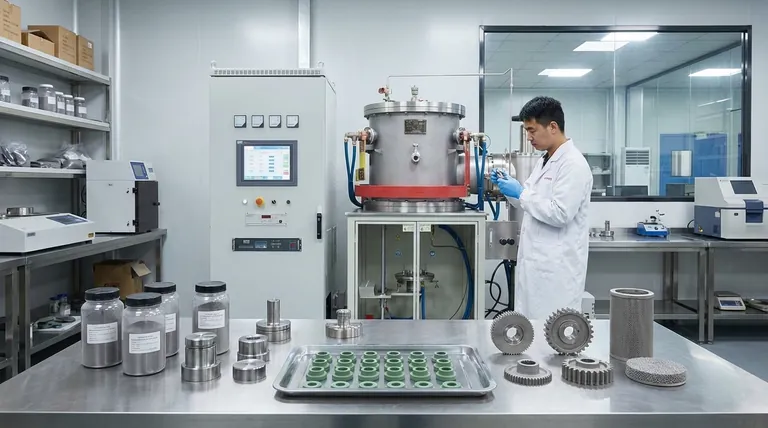At its core, metallurgy is the science of engineering materials to achieve specific outcomes. It provides the fundamental knowledge needed to create, refine, and shape metals for nearly every application imaginable, from building infrastructure to manufacturing advanced electronics. The primary benefits are the ability to develop new materials with superior properties and to optimize production processes for greater efficiency and sustainability.
The true value of metallurgy lies in its ability to control the internal structure of a metal, allowing us to design materials from the atomic level up to solve specific, real-world engineering challenges with precision and minimal waste.

The Core Functions of Modern Metallurgy
Metallurgy is not a single practice but a vast field that delivers benefits across two primary domains: material innovation and process optimization.
Developing Advanced Materials
Metallurgists research and develop new metal alloys to meet the demands of modern technology.
This involves combining elements to create materials with precisely engineered characteristics, such as enhanced strength, superior corrosion resistance, or the ability to withstand extreme temperatures.
Optimizing Production Processes
A major focus of metallurgy is improving how we source and work with metals.
This includes designing more energy-efficient extraction and refining methods, which reduces both cost and environmental impact. It also involves pioneering new manufacturing techniques that use materials more effectively.
A Practical Example: The Power of Powder Metallurgy
To understand these benefits in a real-world context, consider powder metallurgy, a specialized manufacturing process that showcases the advantages of precise material control. It involves pressing metal powders into a mold and then heating (sintering) them to bond the particles together.
Creating Complex Geometries with Precision
Powder metallurgy enables the creation of highly complex external and internal shapes that would be difficult or impossible to produce with traditional casting or machining.
The molds and dies used in this process are made with extremely high precision, allowing for the mass production of intricate parts with repeatable accuracy.
Minimizing Waste and Energy Consumption
This process is considered a green technology because very little material is wasted. The part is formed directly into its final (or near-final) shape.
Furthermore, because the metal is never fully melted, the energy consumption is significantly lower than in traditional foundry processes, leading to cost savings and a smaller environmental footprint.
Engineering Unique Material Properties
Powder metallurgy allows for unique structural control. For instance, the process can intentionally create a certain level of porosity within the final part.
This porosity can be a designed feature, used to hold lubricants for self-lubricating bearings or to provide natural vibration dampening. Despite this, the resulting parts remain strong and durable for their intended application.
Understanding the Trade-offs
No single metallurgical process is a universal solution. Understanding the limitations is key to making informed engineering decisions.
High Initial Tooling Costs
Techniques like powder metallurgy require significant upfront investment in creating the precise molds and dies needed for production.
This makes the process most cost-effective for large, repeatable production runs where the initial tooling cost can be amortized over thousands of parts.
Material and Size Constraints
Not all metals or alloys are suitable for every process. Sintering, for example, works best with certain materials and is often limited to producing relatively small components.
Inherent Physical Properties
The controlled porosity that is a benefit in some applications can be a drawback in others. If a part requires the absolute maximum density and strength found in forged metal, a process like powder metallurgy may not be the optimal choice.
Matching Metallurgical Techniques to Your Goal
The right approach depends entirely on your specific objective. By understanding the core benefits, you can align the discipline's capabilities with your project's needs.
- If your primary focus is innovation and performance: Leverage metallurgical R&D to create novel alloys with unique properties tailored to demanding applications.
- If your primary focus is mass-producing complex parts efficiently: A process like powder metallurgy offers an exceptional solution for achieving high precision while minimizing material waste and energy use.
- If your primary focus is sustainability: Apply metallurgical principles to optimize raw material extraction and select manufacturing processes with the lowest environmental and energy footprint.
Ultimately, metallurgy provides the essential toolkit for transforming raw elemental metals into the high-performance building blocks of modern technology.
Summary Table:
| Benefit | Key Advantage | Common Application |
|---|---|---|
| Material Innovation | Develops alloys with superior strength, corrosion resistance, and heat tolerance. | Aerospace, electronics, medical devices. |
| Process Optimization | Enables energy-efficient production and minimizes material waste. | Automotive parts, industrial machinery. |
| Complex Geometries | Creates intricate, high-precision parts with minimal machining. | Gears, filters, self-lubricating bearings. |
| Sustainability | Reduces environmental impact through green technologies like powder metallurgy. | Sustainable manufacturing, resource efficiency. |
Ready to leverage the power of metallurgy in your lab? KINTEK specializes in providing the advanced lab equipment and consumables needed for metallurgical research and development. Whether you are developing new alloys or optimizing production processes, our solutions are designed to enhance your efficiency and precision. Contact us today to discover how we can support your laboratory's specific needs and help you achieve superior material performance.
Visual Guide

Related Products
- 2200 ℃ Tungsten Vacuum Heat Treat and Sintering Furnace
- Vacuum Heat Treat and Molybdenum Wire Sintering Furnace for Vacuum Sintering
- Graphite Vacuum Furnace High Thermal Conductivity Film Graphitization Furnace
- 1200℃ Controlled Atmosphere Furnace Nitrogen Inert Atmosphere Furnace
- Anti-Cracking Press Mold for Lab Use
People Also Ask
- What is the sintering time? A Critical Process Variable for Material Density and Strength
- Why would you braze instead of solder? For Superior Joint Strength and High-Temperature Performance
- What is the operating temperature of a furnace? From Home Heating to Industrial Processing
- What are the methods of brazing heating? Choose the Right Method for Your Production Needs
- How is heating done in sintering operation? Master the Core Methods for Dense, Strong Parts



















